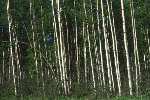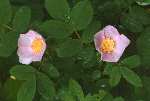









|
|
Central Mixedwood Vegetation
 The vegetation of the Central Mixedwood Subregion is similar to that of the
Dry Mixedwood Subregion with many community types in common. The differences are largely in the proportion of various vegetation types and other landscape features. Aspen is the characteristic forest
species occurring in both pure and mixed stands while balsam poplar frequently occurs with aspen especially on moister sites in depressions and along streams. The vegetation of the Central Mixedwood Subregion is similar to that of the
Dry Mixedwood Subregion with many community types in common. The differences are largely in the proportion of various vegetation types and other landscape features. Aspen is the characteristic forest
species occurring in both pure and mixed stands while balsam poplar frequently occurs with aspen especially on moister sites in depressions and along streams.
Paper birch also occurs commonly with aspen. It forms nearly pure stands infrequently,
a good example of this can be seen in the Christina Highland north of Lac La
Biche. The reason for this is not clear although it may be related to sandy soils.
Due to the process of succession, white spruce and, eventually, balsam fir can be expected to increase or replace aspen and balsam poplar as stand dominants. However, frequent fires seldom
permit this to occur and, therefore, pure deciduous stands are common in the southern part of the Subregion. Further north,
coniferous species are more common with mixed stands of aspen and white spruce being widespread. Older stands in protected sites, such as islands, may have significant amounts of balsam fir.
 Upland aspen forests contain a diverse understory that may include
Low-bush Cranberry, Beaked Hazelnut, Prickly Rose, Red-osier Dogwood,
Marsh Reed Grass, Sarsaparilla, Dewberry, Cream-coloured Peavine, Pink
Wintergreen and Twinflower. Both Balsam Poplar and Paper Birch may occur in these forests as well. Upland aspen forests contain a diverse understory that may include
Low-bush Cranberry, Beaked Hazelnut, Prickly Rose, Red-osier Dogwood,
Marsh Reed Grass, Sarsaparilla, Dewberry, Cream-coloured Peavine, Pink
Wintergreen and Twinflower. Both Balsam Poplar and Paper Birch may occur in these forests as well.
Coniferous-dominated, spruce or spruce-fir forests are not common but generally have a less diverse understory with greater moss cover especially of the feather mosses.
Mixedwood forests, containing a mosaic of deciduous and coniferous patches with species typical of each are widespread throughout the Subregion and characteristic of upland sites.
 Jack pine forests typically occupy dry, sandy upland sites. These may be quite open and have a prominent ground cover of lichens. Other understory species may include
Bearberry, Low Bilberry, Bog Cranberry, and Prickly Rose. Jack pine forests typically occupy dry, sandy upland sites. These may be quite open and have a prominent ground cover of lichens. Other understory species may include
Bearberry, Low Bilberry, Bog Cranberry, and Prickly Rose.
Fluvial deposits along major stream valleys have white spruce or white spruce-balsam poplar forests that often contain large trees that have benefited from the favourable nutrient and moisture regimes of these sites. Gleyed
Luvisols and Gleysolics are typical of these sites.
Peatland complexes typically contain both nutrient-poor, acidic
bog portions, dominated by black spruce, peat mosses, and more nutrient-rich fens containing tamarack, dwarf birches, sedges, and brown mosses. Patterned
peatlands occur commonly in several areas.
Information provided by and printed with the permission of Alberta
Community Development, Parks
and Protected Areas.
[Geology
and Landforms][Climate][Soils]
[Vegetation][Wildlife]
|
 Heritage Community Foundation Presents
Heritage Community Foundation Presents













